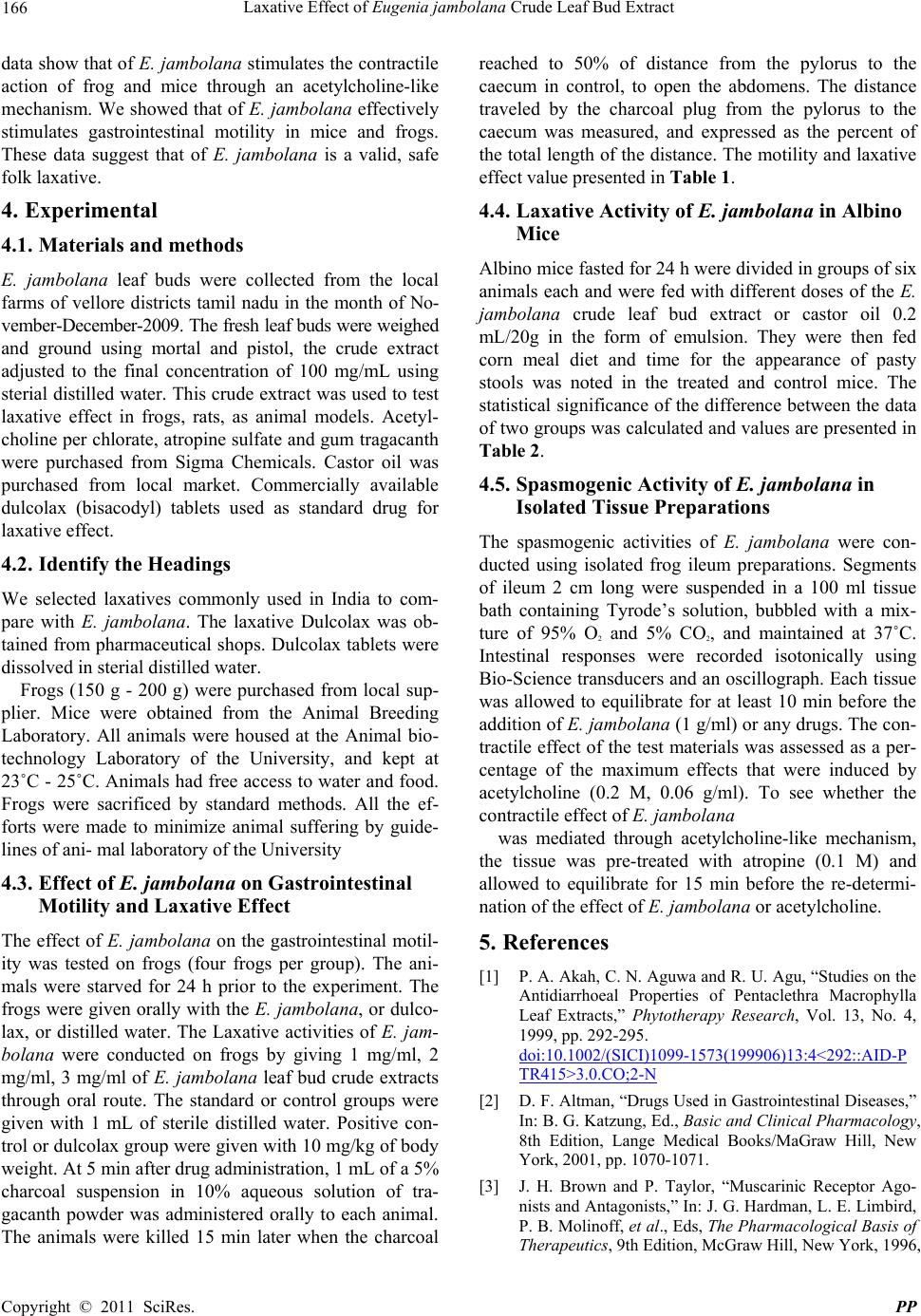
166 Laxative Effect of Eugenia jambolana Crude Leaf Bud Extract
data show that of E. jambolana stimulates the contractile
action of frog and mice through an acetylcholine-like
mechanism. We showed that of E. jambolana effectively
stimulates gastrointestinal motility in mice and frogs.
These data suggest that of E. jambolana is a valid, safe
folk laxative.
4. Experimental
4.1. Materials and methods
E. jambolana leaf buds were collected from the local
farms of vellore districts tamil nadu in the month of No-
vember-December-2009. The fresh leaf buds were weighed
and ground using mortal and pistol, the crude extract
adjusted to the final concentration of 100 mg/mL using
sterial distilled water. This crude extract was u sed to test
laxative effect in frogs, rats, as animal models. Acetyl-
choline per chlorate, atropine sulfate and gum tragacanth
were purchased from Sigma Chemicals. Castor oil was
purchased from local market. Commercially available
dulcolax (bisacodyl) tablets used as standard drug for
laxative effect.
4.2. Identify the Headings
We selected laxatives commonly used in India to com-
pare with E. jambolana. The laxative Dulcolax was ob-
tained from pharmaceutical shops. Dulcolax tablets were
dissolved in sterial distilled water.
Frogs (150 g - 200 g) were purchased from local sup-
plier. Mice were obtained from the Animal Breeding
Laboratory. All animals were housed at the Animal bio-
technology Laboratory of the University, and kept at
23˚C - 25˚C. Animals had free access to water and food.
Frogs were sacrificed by standard methods. All the ef-
forts were made to minimize animal suffering by guide-
lines of ani- mal laboratory of the University
4.3. Effect of E. jambolana on Gastrointestinal
Motility and Laxative Effect
The effect of E. jambolana on the gastrointestinal motil-
ity was tested on frogs (four frogs per group). The ani-
mals were starved for 24 h prior to the experiment. The
frogs were given orally with the E. jambolana, or du lco-
lax, or distilled water. The Laxative activities of E. jam-
bolana were conducted on frogs by giving 1 mg/ml, 2
mg/ml, 3 mg/ml of E. jambolana leaf bud crude extracts
through oral route. The standard or control groups were
given with 1 mL of sterile distilled water. Positive con-
trol or dulco lax group were give n with 10 mg /kg of bod y
weight. At 5 min after drug administration, 1 mL of a 5%
charcoal suspension in 10% aqueous solution of tra-
gacanth powder was administered orally to each animal.
The animals were killed 15 min later when the charcoal
reached to 50% of distance from the pylorus to the
caecum in control, to open the abdomens. The distance
traveled by the charcoal plug from the pylorus to the
caecum was measured, and expressed as the percent of
the total length of the d istance. The motility and laxativ e
effect value presented in Table 1.
4.4. Laxative Activity of E. jambolana in Albino
Mice
Albino mice fasted for 24 h were divided in groups of six
animals each and were fed with different doses of the E.
jambolana crude leaf bud extract or castor oil 0.2
mL/20g in the form of emulsion. They were then fed
corn meal diet and time for the appearance of pasty
stools was noted in the treated and control mice. The
statistical significance of the difference between the data
of two groups was calculated and values are presented in
Table 2.
4.5. Spasmogenic Activity of E. jambolana in
Isolated Tissue Preparations
The spasmogenic activities of E. jambolana were con-
ducted using isolated frog ileum preparations. Segments
of ileum 2 cm long were suspended in a 100 ml tissue
bath containing Tyrode’s solution, bubbled with a mix-
ture of 95% O2 and 5% CO2, and maintained at 37˚C.
Intestinal responses were recorded isotonically using
Bio-Science tran sducers and an oscillograph. Each tissue
was allowed to equilibrate for at least 10 min before the
addition of E. jambolana (1 g/ml) or an y drugs. Th e con-
tractile effect of the test materials was assessed as a per-
centage of the maximum effects that were induced by
acetylcholine (0.2 M, 0.06 g/ml). To see whether the
contractile effect of E. jambolana
was mediated through acetylcholine-like mechanism,
the tissue was pre-treated with atropine (0.1 M) and
allowed to equilibrate for 15 min before the re-determi-
nation of the effect of E. jambolana or acetylcholine.
5. References
[1] P. A. Akah, C. N. Aguwa and R. U. Agu, “Studies on the
Antidiarrhoeal Properties of Pentaclethra Macrophylla
Leaf Extracts,” Phytotherapy Research, Vol. 13, No. 4,
1999, pp. 292-295.
doi:10.1002/(SICI)1099-1573(199906)13:4<292::AID-P
TR415>3.0.CO;2-N
[2] D. F. Altman, “Drugs Used in Gastrointestinal Diseases,”
In: B. G. Katzung, Ed., Basic and Clinical Pharmacology,
8th Edition, Lange Medical Books/MaGraw Hill, New
York, 2001, pp. 1070-1071.
[3] J. H. Brown and P. Taylor, “Muscarinic Receptor Ago-
nists and Antagonists,” In: J. G. Hardman, L. E. Limbird,
P. B. Molinoff, et al., Eds, The Pharmacological Basis of
Therapeutics, 9th Edition, McGraw Hill, New York, 1996,
C
opyright © 2011 SciRes. PP